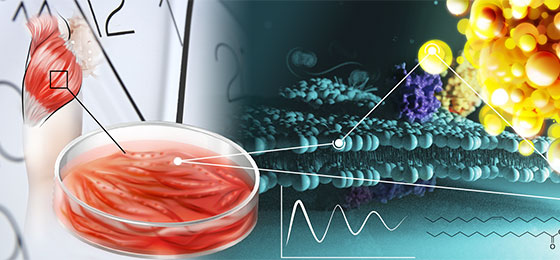Our muscles measure the time of day

Source: SNF
Biological clocks are ticking everywhere throughout our body. They trigger the release of the hormone melatonin during sleep, favour the secretion of digestive enzymes at lunchtime or keep us awake at the busiest moments of the day.
A “master clock” in the brain synchronises all the subsidiary ones in various organs. For the first time, researchers funded by the Swiss National Science Foundation (SNSF) found that such a circadian clock is at work in our muscles. Perturbations of this machinery might be important for type 2 diabetes development. Their work has just been published in the magazine PNAS (*).
Sampling muscle tissue around the clock
Researchers from the University of Geneva, the University of Bath, the Université Claude Bernard in Lyon, EPFL, the University of Surrey, and the Nestlé Institute of Health Sciences discovered that levels of the various types of fat (lipids) contained in our muscle cells vary during the day, sometimes favouring one kind of lipid over another. Could a biological clock be at play?
The international team has tested the hypothesis with volunteer subjects. They synchronised every subject's master clock by asking them to adhere to a daily eating and sleeping routine one week prior to the experiment. Every four hours, researchers would take a very small sample of thigh muscle tissue and analyse its lipid composition.
The team observed a clear correlation between the muscle cell's lipid composition and the time of day, explains Howard Riezman, who co-directed the study in Geneva with colleague Charna Dibner. “As the combination of lipids varied substantially from one individual to another, we needed further evidence to corroborate these findings,” he explains.
In a second step, the researchers switched to an in-vitro experiment. They cultivated human muscle cells and artificially synchronised them in the absence of a master clock, using a signal molecule normally secreted in the body. The researchers observed a periodic variation in the cell's lipid composition, similar to what they noticed in human subjects. But when they disrupted the clock mechanism by inhibiting the responsible genes, the periodically changing variations in the lipids were mostly lost.
Diabetes and sleep disorders are linked
“We have clearly shown that this variation of lipid types in our muscles is due to our circadian rhythm,” explains first author Ursula Loizides-Mangold. “But the main question is still to be answered: what is this mechanism for?” Riezman thinks that the biological clock in the muscle, with its impact on the lipids, could help in regulating the cells' sensitivity to insulin. Indeed, lipids – being a component of the cell membrane – influence the molecules' ability to travel into and out of the muscle cells. Changes in its composition could tune the muscle's sensitivity to the hormone as well as its ability to take in blood sugar.
A low sensitivity of the muscle to insulin leads to a condition called insulin resistance, which is known to be a cause of type 2 diabetes. “Studies strongly suggest a link between circadian clocks, insulin resistance and diabetes development,” explains Charna Dibner, the co-director of the study. “If we establish a link between circadian mechanisms and type 2 diabetes via lipid metabolism, this could have important therapeutic implications. Thanks to our new tools for studying human muscle cellular clocks in vitro, we now have the possibility to investigate this hypothesis in our next study.”
(*) U. Loizides-Mangold et al.: Lipidomics reveals diurnal lipid oscillations in human skeletal muscle persisting in cellular myotubes cultured in vitro. PNAS (2017). DOI: 10.1073/pnas.1705821114
Contact
Dr. Charna Dibner
Department of Internal Medicine Specialties
Faculty of Medicine
University of Geneva
Phone: +41 (0)22 372 93 18
E-Mail: charna.dibner@hcuge.ch
Prof. Howard Riezman
Biochemistry Department
Faculty of Sciences
University of Geneva
Phone: +41 (0)22 379 64 69
E-Mail: howard.riezman@unige.ch
Dr. Ursula Loizides-Mangold
Department of Internal Medicine Specialties
Faculty of medicine
University of Geneva
Phone: +41 (0)22 379 5339
E-Mail: Ursula.Loizides-Mangold@unige.ch
Media Contact
All latest news from the category: Life Sciences and Chemistry
Articles and reports from the Life Sciences and chemistry area deal with applied and basic research into modern biology, chemistry and human medicine.
Valuable information can be found on a range of life sciences fields including bacteriology, biochemistry, bionics, bioinformatics, biophysics, biotechnology, genetics, geobotany, human biology, marine biology, microbiology, molecular biology, cellular biology, zoology, bioinorganic chemistry, microchemistry and environmental chemistry.
Newest articles

First-of-its-kind study uses remote sensing to monitor plastic debris in rivers and lakes
Remote sensing creates a cost-effective solution to monitoring plastic pollution. A first-of-its-kind study from researchers at the University of Minnesota Twin Cities shows how remote sensing can help monitor and…

Laser-based artificial neuron mimics nerve cell functions at lightning speed
With a processing speed a billion times faster than nature, chip-based laser neuron could help advance AI tasks such as pattern recognition and sequence prediction. Researchers have developed a laser-based…

Optimising the processing of plastic waste
Just one look in the yellow bin reveals a colourful jumble of different types of plastic. However, the purer and more uniform plastic waste is, the easier it is to…



